High-Purity Alumina (HPA) Market Size
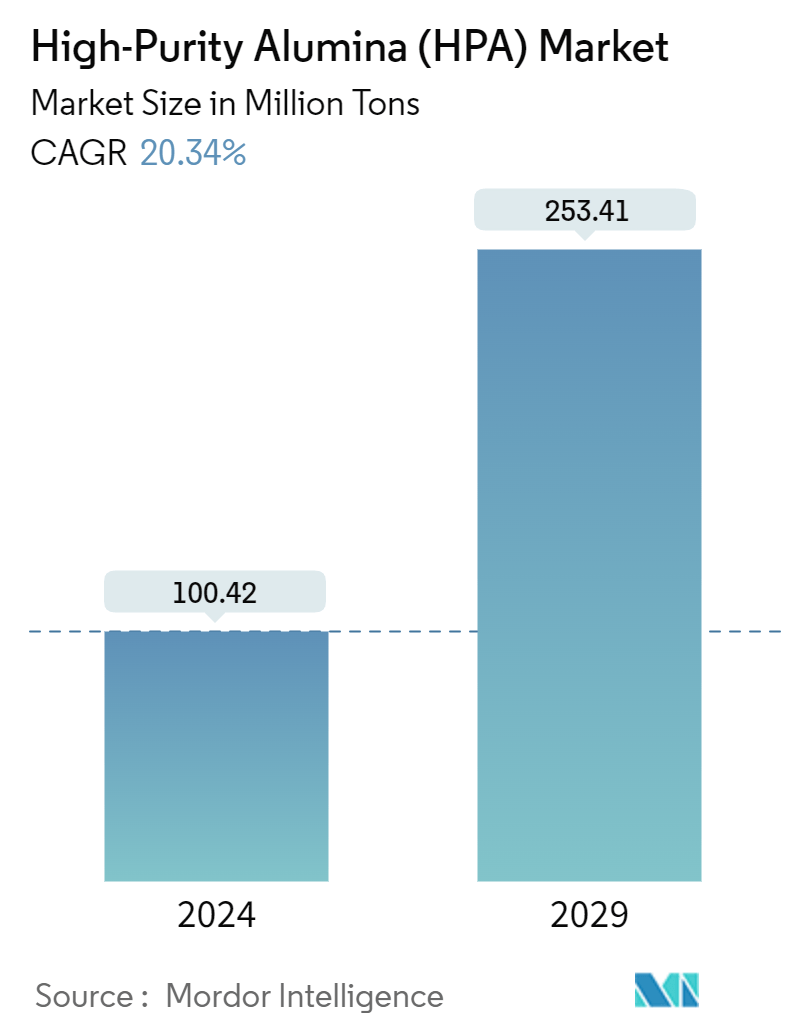
| Study Period | 2019 - 2029 |
| Base Year For Estimation | 2023 |
| CAGR (2024 - 2029) | 20.34 % |
| Fastest Growing Market | Asia Pacific |
| Largest Market | Asia Pacific |
| Market Concentration | High |
Major Players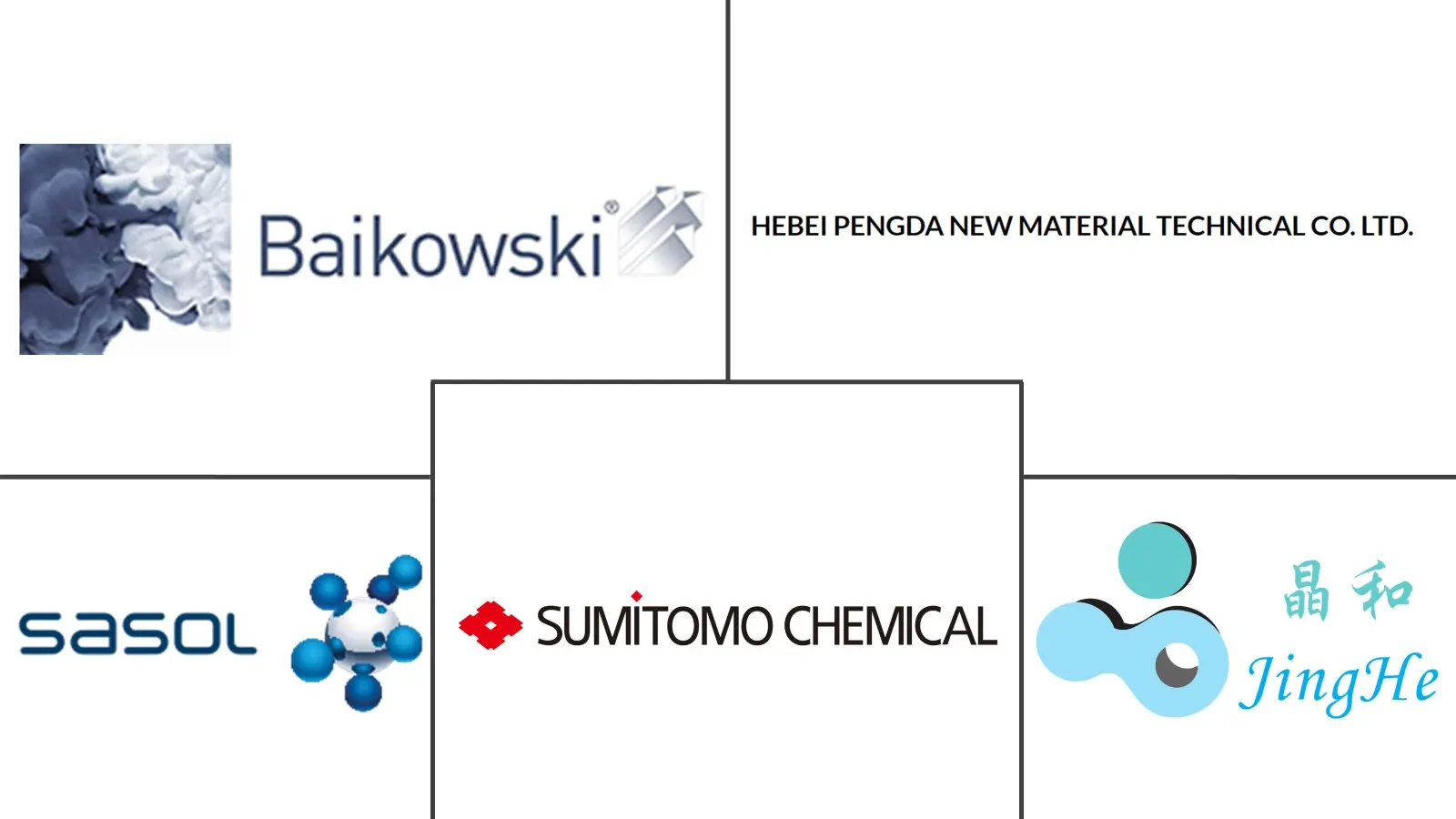
*Disclaimer: Major Players sorted in no particular order |
High-Purity Alumina (HPA) Market Analysis
The High-Purity Alumina Market size is estimated at 100.42 Million tons in 2024, and is expected to reach 253.41 Million tons by 2029, growing at a CAGR of 20.34% during the forecast period (2024-2029).
The COVID-19 pandemic hampered the high-purity alumina market. Initially, the demand for high-purity alumina declined as various industries, including aerospace, automotive, and electronics, scaled back production or temporarily shut down operations in response to lockdown measures. This trend reduced the demand for HPA-based products in applications such as LED lighting, semiconductor manufacturing, and lithium-ion batteries. However, as lockdown and restrictions eased and economic activities resumed, there was pent-up demand for HPA-based products in various industries, such as LED lighting, semiconductor manufacturing, and lithium-ion batteries.
- The increased demand for LED-based lighting and lithium-ion batteries is the major factor driving the market for high-purity alumina.
- However, the high cost of high-purity alumina is expected to hamper the growth of the high-purity alumina market.
- Enormous opportunities are expected for the growth of the high-purity alumina market during the forecast period due to the growing use of HPA in scratch-resistant glasses for smartphones and watches and in the manufacture of optical lenses.
- Asia-Pacific has become the biggest market for high-purity alumina and is projected to register the highest CAGR over the forecast period. The high demand for high-purity alumina in countries such as China, Japan, and Southeast Asia is driving the dominance of Asia-Pacific.
High-Purity Alumina (HPA) Market Trends
The LED Lighting Segment is Expected to Dominate the Market
- High-purity alumina is used as a substrate material to produce LED (light-emitting diode) chips. LED chips are typically mounted on a substrate to provide mechanical support and thermal management. HPA's high thermal conductivity helps dissipate heat efficiently, thus improving the performance and lifespan of LED devices.
- LED lighting has gained widespread adoption due to its energy efficiency, long lifespan, and environmental benefits compared to traditional lighting technologies such as incandescent and fluorescent bulbs. The increasing demand for LED lighting products in residential, commercial, and industrial applications drives the demand for high-purity alumina substrates.
- According to the US Department of Energy, the outdoor segment holds the maximum consumption of LED lighting, which is expected to grow by 93% by 2025.
- According to the International Energy Agency, LEDs save 80-90% more energy than incandescent light bulbs.
- According to the International Energy Agency, in addition to removing virtually all fluorescent lighting in 2023, the European Union updated its regulations under the Ecodesign Directive and the Restriction of Hazardous Substances Directive. In Africa, a regionally harmonized lighting standard has been adopted in 16 countries of the Southern African Development Community in order to introduce all LED lighting to the market in the next few years.
- According to the LED Lighting Supply, LEDs are expected to increase up to 87% of global lighting sources by 2030. The global LED market is expected to grow to almost USD 100 billion in 2030.
- According to TrendForce's most recent reports, the year 2024 will be crucial for the global LED lighting market, with an estimated 5.8 billion LED lamps and luminaires reaching their end-of-life. In 2026, the market is expected to reach a value of more than USD 93 billion. As the global community attempts to achieve net zero emissions, the demand for energy-saving LED conversion is expected to increase.
- Considering all the abovementioned facts and factors, the demand for HPA for LED-based lighting applications is expected to increase during the forecast period.
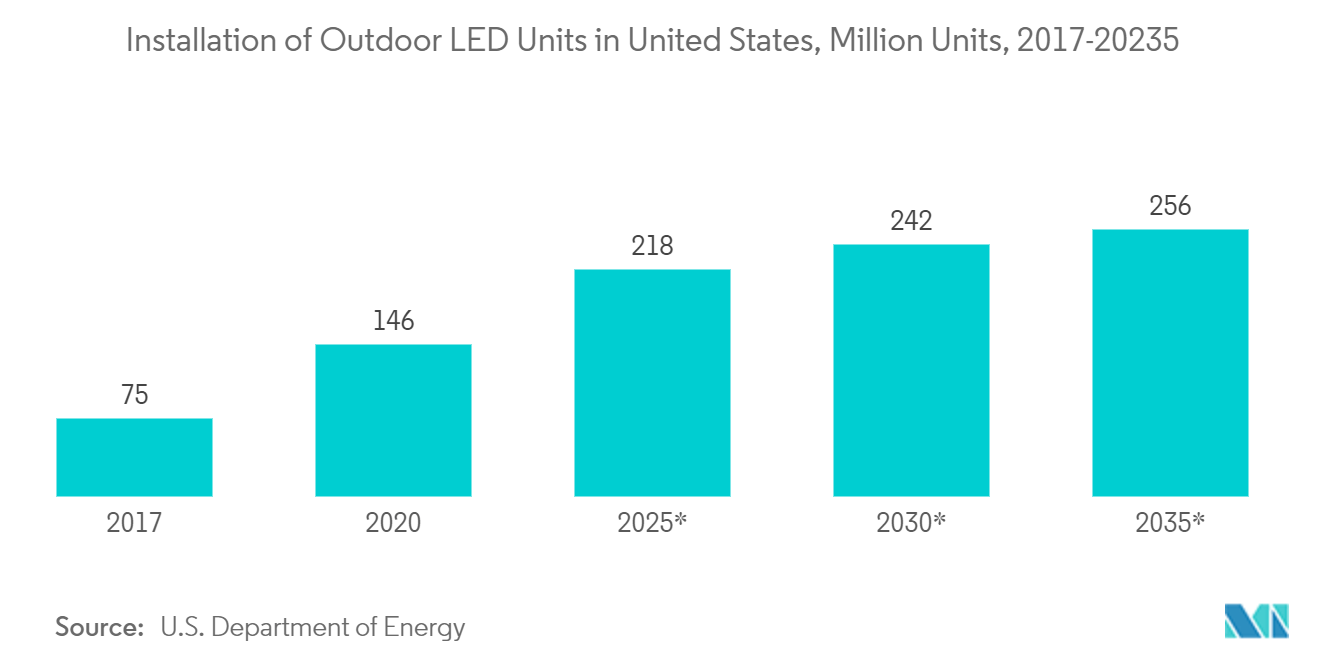
Asia-Pacific is Expected to Dominate the Market
- Asia-Pacific is a central manufacturing hub for high-purity alumina and its end-use products. Countries like China, Japan, South Korea, and Taiwan have established robust manufacturing infrastructures and supply chains for high-purity alumina production and processing.
- The region has experienced rapid urbanization and industrialization, thus driving the demand for advanced materials like high-purity alumina in the automotive, electronics, aerospace, and healthcare sectors. The growing demand for high-purity alumina-based products in these sectors fuels the regional market’s dominance.
- In addition, China is promoting the use of electric vehicles, which may increase the demand for lithium-ion batteries in the future, according to the China Passenger Car Association (CPCA) report. In China, around 9.5 million battery-electric cars and plug-in hybrids were sold in 2023.
- The electric vehicle sales in India reached 23,900 units in Q3 2023, according to the data released by the Economic Times.
- In March 2024, Tata Electronics Private Limited (TEPL), in collaboration with Powerchip Semiconductor Manufacturing Corporation (PSMC) Taiwan, announced its plans to set up a semiconductor fabrication plant (SFC) in the state of Gujarat. The total investment amount of the project is estimated at INR 9,000 billion (USD 109.71 billion). PSMC is one of the six largest semiconductor foundry companies in Taiwan. The capacity will cover segments like high-performance computing (HPC) chips with 28nm technology, processor power management (PPM) chips, electric vehicles (EVs), telecommunication, defense, automobile, and consumer electronics (display, power electronics).
- The growth of the Asia-Pacific high-purity alumina market is expected to be supported by the abovementioned factors over the forecast period.
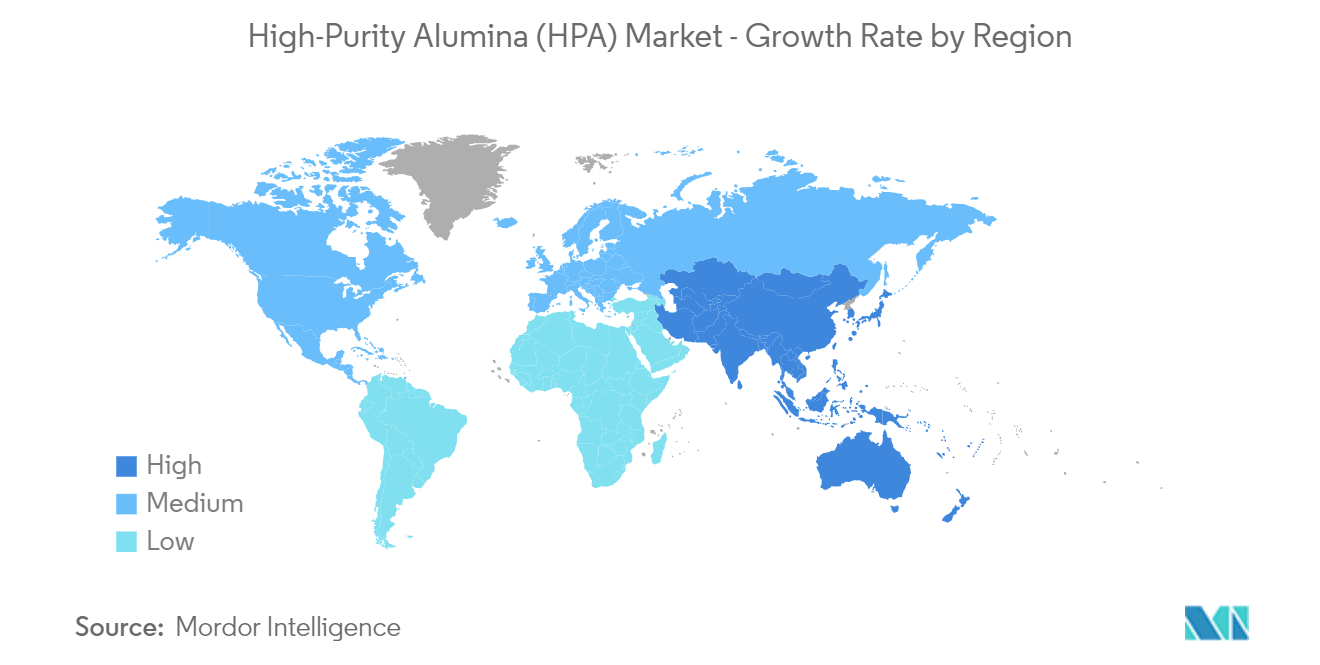
High-Purity Alumina (HPA) Industry Overview
The high-purity alumina market is consolidated in nature, with intense competition among the top market players. The key players in the market (not in any particular order) include Hebei Pengda New Material Technology Co. Ltd, Sumitomo Chemical Co. Ltd, Sasol, Baikowski, and Xuancheng Jingrui New Materials Co. Ltd.
High-Purity Alumina (HPA) Market Leaders
-
Hebei Pengda New Material Technology Co. Ltd
-
Sumitomo Chemical Co. Ltd
-
Baikowski
-
Xuancheng Jingrui New Materials Co. Ltd
-
Sasol
*Disclaimer: Major Players sorted in no particular order
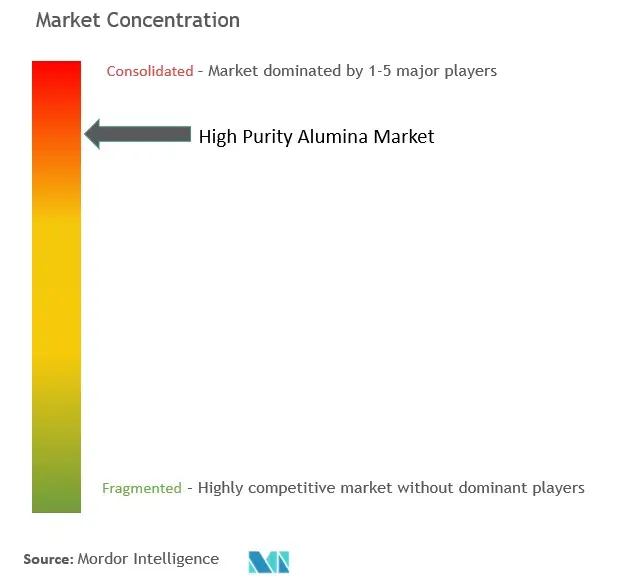
High-Purity Alumina (HPA) Market News
- August 2023: Sumitomo Chemical introduced a new technology for the production of ultra-fine α-alumina, which was set to start in September 2023. Alumina materials that are made by calcining aluminum hydroxide at high temperatures have a purity of around 99.99% or more. They are called ultra-high purity alumina.
- January 2022: Polar Performance Materials was awarded USD 4.1 million by Sustainable Development Technology Canada (SDTC) for Battery Cleantech. SDTC funding will allow Polar Performance Materials to build a demonstration line for manufacturing high-purity alumina that produces lithium-ion batteries.
High Purity Alumina (HPA) Market Report - Table of Contents
1. INTRODUCTION
- 1.1 Study Assumptions
- 1.2 Scope of the Study
2. RESEARCH METHODOLOGY
3. EXECUTIVE SUMMARY
4. MARKET DYNAMICS
-
4.1 Drivers
- 4.1.1 Increasing Demand for LED-based Lighting
- 4.1.2 Demand from Lithium-ion Battery Markets
-
4.2 Restraints
- 4.2.1 High Cost of High-purity Alumina
- 4.3 Industry Value Chain Analysis
-
4.4 Porter's Five Forces Analysis
- 4.4.1 Bargaining Power of Suppliers
- 4.4.2 Bargaining Power of Buyers
- 4.4.3 Threat of New Entrants
- 4.4.4 Threat of Substitute Products and Services
- 4.4.5 Degree of Competition
5. MARKET SEGMENTATION (Market Size in Volume)
-
5.1 Type
- 5.1.1 4N
- 5.1.2 5N
- 5.1.3 6N
-
5.2 Technology
- 5.2.1 Hydrolysis
- 5.2.2 Hydrochloric Acid Leaching
-
5.3 Application
- 5.3.1 LED Lighting
- 5.3.2 Phosphor
- 5.3.3 Semiconductor
- 5.3.4 Lithium-ion (Li-Ion) Batteries
- 5.3.5 Technical Ceramics
- 5.3.6 Other Applications
-
5.4 Geography
- 5.4.1 Asia-Pacific
- 5.4.1.1 China
- 5.4.1.2 India
- 5.4.1.3 Japan
- 5.4.1.4 South Korea
- 5.4.1.5 Malaysia
- 5.4.1.6 Thailand
- 5.4.1.7 Indonesia
- 5.4.1.8 Vietnam
- 5.4.1.9 Rest of Asia-Pacific
- 5.4.2 North America
- 5.4.2.1 United States
- 5.4.2.2 Canada
- 5.4.2.3 Mexico
- 5.4.3 Europe
- 5.4.3.1 Germany
- 5.4.3.2 United Kingdom
- 5.4.3.3 France
- 5.4.3.4 Italy
- 5.4.3.5 Spain
- 5.4.3.6 NORDIC Countries
- 5.4.3.7 Turkey
- 5.4.3.8 Russia
- 5.4.3.9 Rest of Europe
- 5.4.4 South America
- 5.4.4.1 Brazil
- 5.4.4.2 Argentina
- 5.4.4.3 Colombia
- 5.4.4.4 Rest of South America
- 5.4.5 Middle East and Africa
- 5.4.5.1 Saudi Arabia
- 5.4.5.2 Qatar
- 5.4.5.3 United Arab Emirates
- 5.4.5.4 Nigeria
- 5.4.5.5 Egypt
- 5.4.5.6 South Africa
- 5.4.5.7 Rest of Middle East and Africa
6. COMPETITIVE LANDSCAPE
- 6.1 Market Share (%) Analysis
- 6.2 Strategies Adopted by Leading Players
-
6.3 Company Profiles
- 6.3.1 Baikowski
- 6.3.2 Bestry Performance Materials Co. Ltd
- 6.3.3 Hebei Pengda New Material Technology Co. Ltd
- 6.3.4 Honghe Chemical
- 6.3.5 Nippon Light Metal Co. Ltd
- 6.3.6 Polar Sapphire
- 6.3.7 Rusal
- 6.3.8 Sasol (USA) Corporation
- 6.3.9 Shandong Keheng Crystal Material Technology Co. Ltd
- 6.3.10 Sumitomo Chemical Co. Ltd
- 6.3.11 Wuxi Tuobada Titanium Dioxide Products Co. Ltd
- 6.3.12 Xuancheng Jingrui New Materials Co. Ltd
- *List Not Exhaustive
7. MARKET OPPORTUNITIES AND FUTURE TRENDS
- 7.1 Application in Scratch-resistant Glasses for Smartphones and Watches
- 7.2 Growing Applications in Manufacturing Optical Lenses
High-Purity Alumina (HPA) Industry Segmentation
High-purity alumina (HPA), also known as high-purity aluminum oxide, refers to a refined form of aluminum oxide with a purity level typically exceeding 99.99%. It is produced through various processes that involve the purification and crystallization of aluminum oxide from raw materials such as bauxite or aluminum hydroxide. It has high thermal conductivity, chemical resistance, hardness, and optical transparency.
The high-purity alumina market is segmented by type, technology, application, and geography. By type, the market is segmented into 4N, 5N, and 6N. By technology, the market is segmented into hydrolysis and hydrochloric acid leaching. By application, the market is segmented into LED lighting, phosphor, semiconductors, lithium-ion (Li-Ion) batteries, technical ceramics, and other applications (sapphire glass). The report also covers the market size and forecasts for the high-purity alumina (HPA) market in 27 countries across major regions. For each segment, market sizing and forecasts have been done based on volume (tons).
| Type | 4N | |
| 5N | ||
| 6N | ||
| Technology | Hydrolysis | |
| Hydrochloric Acid Leaching | ||
| Application | LED Lighting | |
| Phosphor | ||
| Semiconductor | ||
| Lithium-ion (Li-Ion) Batteries | ||
| Technical Ceramics | ||
| Other Applications | ||
| Geography | Asia-Pacific | China |
| India | ||
| Japan | ||
| South Korea | ||
| Malaysia | ||
| Thailand | ||
| Indonesia | ||
| Vietnam | ||
| Rest of Asia-Pacific | ||
| Geography | North America | United States |
| Canada | ||
| Mexico | ||
| Geography | Europe | Germany |
| United Kingdom | ||
| France | ||
| Italy | ||
| Spain | ||
| NORDIC Countries | ||
| Turkey | ||
| Russia | ||
| Rest of Europe | ||
| Geography | South America | Brazil |
| Argentina | ||
| Colombia | ||
| Rest of South America | ||
| Geography | Middle East and Africa | Saudi Arabia |
| Qatar | ||
| United Arab Emirates | ||
| Nigeria | ||
| Egypt | ||
| South Africa | ||
| Rest of Middle East and Africa |
High Purity Alumina (HPA) Market Research FAQs
How big is the High-Purity Alumina Market?
The High-Purity Alumina Market size is expected to reach 100.42 million tons in 2024 and grow at a CAGR of 20.34% to reach 253.41 million tons by 2029.
What is the current High-Purity Alumina Market size?
In 2024, the High-Purity Alumina Market size is expected to reach 100.42 million tons.
Who are the key players in High-Purity Alumina Market?
Hebei Pengda New Material Technology Co. Ltd, Sumitomo Chemical Co. Ltd, Baikowski, Xuancheng Jingrui New Materials Co. Ltd and Sasol are the major companies operating in the High-Purity Alumina Market.
Which is the fastest growing region in High-Purity Alumina Market?
Asia Pacific is estimated to grow at the highest CAGR over the forecast period (2024-2029).
Which region has the biggest share in High-Purity Alumina Market?
In 2024, the Asia Pacific accounts for the largest market share in High-Purity Alumina Market.
What years does this High-Purity Alumina Market cover, and what was the market size in 2023?
In 2023, the High-Purity Alumina Market size was estimated at 79.99 million tons. The report covers the High-Purity Alumina Market historical market size for years: 2019, 2020, 2021, 2022 and 2023. The report also forecasts the High-Purity Alumina Market size for years: 2024, 2025, 2026, 2027, 2028 and 2029.
High Purity Alumina Industry Report
The Global High Purity Alumina Market Analysis report provides a comprehensive overview of the market, segmented by type, technology, application, and geography. The market is analyzed based on its market share, market size, and market growth. The industry report offers a detailed industry analysis, including historical data and market forecast outlook. The report also highlights the market leaders and their contributions to the market trends.
The report includes industry information and industry statistics, providing insights into the market segmentation and market value. The industry outlook and industry research are covered, along with industry sales and industry size. The market data and market predictions are presented in a clear and concise manner, supported by industry reports and industry trends.
Additionally, the report provides a market review and market overview, discussing the market outlook and market forecast. The report example and report PDF are available for further reference. Research companies have contributed to the market research, ensuring accurate and reliable data. The growth rate of the market is analyzed, offering insights into the future market growth.
Overall, the Global High Purity Alumina Market Analysis report is a valuable resource for understanding the current market dynamics and future market trends. The report covers all essential aspects, making it a comprehensive guide for stakeholders and industry participants.



